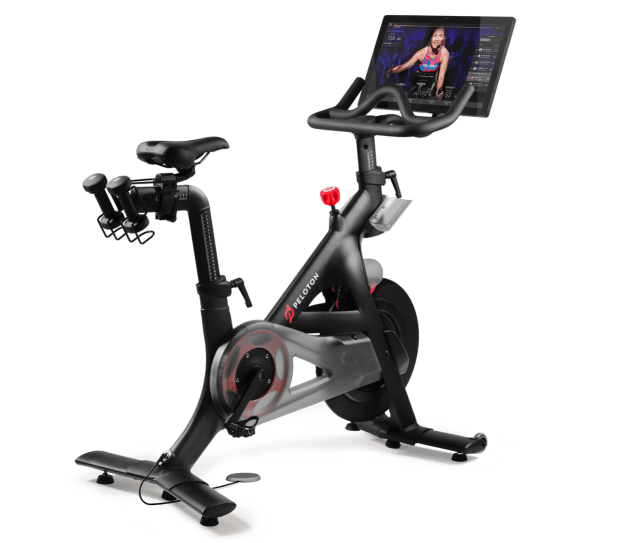
An exercise bike is perfect for those times you want to ride your bike but without the hassle of going outside.
Perhaps the weather is poor, or your coach has prescribed you a set of intervals that would be tricky to replicate outside, training indoors is a vital tool for all cyclists. With all the kits and programs you can use indoors nowadays, it’s easy to be tempted to stay inside when the weather is foul.
In this article, we’ll explain the different types of indoor training and the equipment you can use, such as indoor cycling bikes, indoor bike trainers, and workout bikes to name a few.
Terminology Explained
- Turbo trainer – A static device upon which you mount your bike. There are two types, wheel-on, and wheel-off. This denotes how the bike connects to the trainer.
- Smart Trainer – A smart trainer is a turbo trainer that can be used in conjunction with workout programs such as Zwift. They usually come with built-in power meters and ‘smart’ capabilities.
- Rollers – These are quite literally some rolled tubes that you ride over, staying in the same place. The bike does not attach to the roller, and it is only kept upright by forwarding momentum.
The 4 Different Types of Exercise Bikes

- Bike Simulator
- Recumbent
- Upright
- Exercise Bike with a flywheel (Similar to spin bikes used in the gym for group sessions)
Bike Simulators

Wahoo Fitness – Kickr Bike [MSRP $3,500 REI.com]
- Bluetooth, Smart connectivity
- Expensive
- Advanced workouts
One of the most expensive options for your indoor cycle training hobby is a bike simulator.
These home bike trainers are designed to replace your bike indoors. They are manufactured in a way that makes them adjustable to suit different heights and riding positions. They’re also designed to be used in conjunction with training apps and programs such as Zwift, Sufferfest, Rouvy, and others. These static bikes are great tools for intervals and specific workouts that you might not be able to match on the roads.
They come equipped with Bluetooth and Smart connectivity, enabling them to be run on programs such as Zwift. The main downside to these types of trainers is the cost. The Wahoo Kickr Bike, for example, costs $3,500. Additionally, these types of bikes are quite big and aren’t folded away easily.
Of course, they are at the top of the game when it comes to smart features so it depends on your budget on what type of indoor trainer is best for you and your needs.
Indoor Exercise Bikes

- Large flywheel
- No console
- Best for intense cycling workouts
These are one of the most popular types of indoor cycling machines.
Most often found in indoor exercise studios, these training bikes are perfect for those wanting to get a high-intensity workout from the comfort of their homes. Furthermore, although the outlay could be costly, you may end up saving yourself money in the long run by not buying expensive gym memberships or classes.
Those are set up in a more racey position than recumbent bikes or other indoor training apparatus. They often come as an exercise bike with arms, i.e. multiple bars for different positions. This is great for different types of training such as sprinting and HIIT, or longer more controlled intervals as you can adopt different positions on the bike.
Those stationary bikes use large flywheels for their resistance and are controlled through knobs found on the bike. One difference between this type of exercise bike to other smart trainers is that they are generally not compatible with programs such as Zwift, as they don’t generally come with consoles or Bluetooth technology.
They are ideal for those looking for high-intensity cycling workouts, and there are plenty of options to cater to multiple budgets.
Price Range
Cheap exercise bikes cost around $200 – $400 while advanced high-quality bikes can cost over $1,000. What makes these bikes not as expensive as Smart Trainers is the lack of electronic technology packed into them.
Recumbent Exercise Bikes

Schwinn 270 Recumbent Bike
- Cheap
- Comfortable
- Low-resistance
- Best exercise bike seniors and beginners alike
Recumbent bikes are another type of home cycling bike.
These are built so you’re riding in a more seated, laid-back position, like a recumbent bicycle. They are ideal for indoor recreational cycling purposes as well as gym workouts and cooldowns. The position means you’re slightly more relaxed than on an exercise bike or upright static bike.
This makes recumbent bikes perfect for seniors, beginners, or those rehabbing an injury as there is less pressure on your joints.
One downside to these sit-down exercise bikes is the fact they can’t be folded away. Of course, they take up far less room than say a treadmill, but they’re still quite long and require quite a bit of space.
Recumbent stationary bikes are among the cheapest on the market, making them popular with those on a budget.
Technology varies between brands and models but typically you can change the resistance on a console and there are multiple workout options for you to choose from.
Price Range
Recumbent bike prices are among the lowest in the market of stationary bikes making them perfect for beginners or those looking to expand their home gym on a budget.
Upright Exercise Bikes

- Cheap
- Comfortable
- Drivetrain: Chain / Belt
- Resistance
Upright exercise bikes are probably closer to what you think of when envisioning indoor cycling.
The upright exercise bike is built like a bike, just without wheels. You are positioned more upright and over the pedals compared to say a recumbent exercise cycle. The main benefit of this position is that you can be comfortable while increasing the power output. They are great for intervals and often come with displays for you to read workouts on or see your riding metrics.
Prices can vary, but upright exercise bikes are among the best value for money. Many big-name brands manufacture upright bikes, such as the Schwinn indoor cycling bikes. A well-known brand across the globe, they have dipped their toes into most indoor cycling categories, including upright exercise bikes.
Upright exercise bikes can offer a great workout that’s easy on your joints and at price points that are generally more affordable than other types of indoor training.
Price Range
Upright exercise bikes are entry-level stationary bikes for home use. Upright bikes start as low as $100 but can go for upwards of $1,500 depending on the technology installed.
Peloton Bike

Peloton Bike [Starting from $1,895 OnePeloton.com]
- Speakers + HD screen
- Monthly subscription
- Dumbbells included
Peloton is not a specific type of indoor bike. Instead, it is a brand.
They have seen a meteoric rise in popularity over the last couple of years, and there are many reasons why. One of the best bike riding exercise machines available, its key selling point is the technology and integration of live workouts. Peloton bikes come with a large HD screen and use the Peloton software for you to interact with.
Although these high-tech bikes are great bits of kit, they do come at a cost. Not only is the outlay quite significant at just under $2,000, but to use the Peloton technology you are required to purchase a subscription. Of course, if challenging yourself at home with online fitness classes is what you’re after, then there’s not much better out there. In addition to cycling classes, Peloton also hosts yoga, strength, and other cardio classes.
Indoor Exercise Bikes Buying Guide
Chain vs. Belt Drive Pros and Cons
There are two main drive systems used in stationary bikes; chain and belt drives.
Chain drives are generally found on cheaper models and they look similar to that of a regular bike’s drivetrain. I.e. there is a chain that is driven across sprockets when pedaling. They do require some maintenance just like regular bike chains.
Belt drives are typically made with hard-wearing rubber and are often quieter than chain drives. They typically appear on more modern or expensive stationary bikes and require minimal maintenance and last for a long time.
Belt
+ Smooth
+ Quiet
– Not as authentic feel to the ride
Chain
+ Cheaper
+ Authentic feel to the ride
– Can be a bit noisy
Types of Resistance
There are two main types of resistance found on stationary bikes, magnetic and air.
- Magnetic resistance uses magnets to create resistance against a flywheel. These bikes offer varying degrees of resistance, controlled either through a digital monitor or a manual adjusting knob. Magnetic resistance bikes are generally quiet because the magnets don’t make contact with the flywheel. They’re also durable and easy to maintain.
- Air resistance bikes use fan blades to create resistance against the air. The quicker you pedal, the harder the resistance. These bikes are great for HIIT workouts or sprinting but aren’t as quiet as magnetic resistance-styled bikes.
Treadmill vs. Exercise Bike
If you’re after a satisfying indoor workout, then either an exercise bike or treadmill is a great investment.
Exercise bikes can provide a safer exercise experience and are often used in injury rehabilitation. Cycling doesn’t put as much pressure on your joints as it’s not a weight-loading exercise so it’s great for beginners.
Treadmills are great for those looking to spice up their cycling and include some alternative cardio. They are both similar in price ranges and technologies, with many now compatible with programs such as Zwift.
Deciding on a treadmill or an exercise bike depends on your goals. If you’re after something to do indoors when the weather is bad, or whether you’re looking for targeted intervals to supplement your outdoor training, there is something for everyone.
Conclusion
Stationary bikes are great for those who have enough permanent space to include one in their homes.
They are great tools for cycling workouts when you want to ride indoors. Both belt and chain drives have their positives, but the higher-end models usually lean towards belt drives. This is because they are quieter and are more durable than chain drives.
Resistance-wise, it’s down to personal preference. Fan and air resistance bikes change the resistance based on how hard/fast you pedal. Whereas, magnetic resistance bikes can be altered using a knob or digital screen and are better for longer or more controlled intervals.



